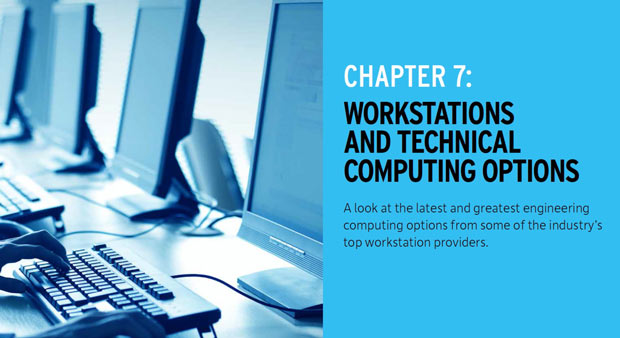Keep Up with Changing Engineering Workstation Technology
Latest News
January 5, 2016
 Dear Desktop Engineering Reader:
Dear Desktop Engineering Reader:
The old quip “the only two certainties in life are death and taxes” needs updating. It should say: “The only three certainties are death, taxes and technology change.” In three to five years your top-of-the-line desktop workstation will certainly be out-classed by new compute technology. That’s OK. Still, rapid change can leave you behind in a stroke. Today’s Check it Out read is about where engineering compute resources are right now and what you need to know to make them work to your advantage today.
The promise of The Design Engineer’s High-Performance Computing Handbook from DE and Intel from the start is that it will evolve with technology. It’s a fair bet that no chapter will change as quickly as chapter 7, “Workstations and Technical Computing Options,” because hardware’s evolution does not sleep.See, every time a performance factor, say, thread counts or supported cores, changes, your design and engineering applications rush in to leverage the increased power. That means you soon need more computational horsepower, which means engineers are hard at work obsoleting today’s best technologies. What do you do? You need power now.
Chapter 7 reviews your current options clearly and concisely. It focuses on desktop workstations, although it touches upon virtual and cloud-based computing. Earlier chapters scrutinized mobile workstations and virtual desktops, respectively. (When you download chapter 7 from today’s Check it Out link, you’ll also receive all preceding chapters.)
This is a sweeping, multi-media rich overview. It begins with a brief summary of form factors like desktops and servers. There are at least eight links to in-depth details on topics like CAD value and workstation performance, cloud appliances and anywhere/anytime simulation. Two sidebars bring you up to date on the newest graphics processing and CPU technologies.
The chapter wraps with a three-part presentation on state of the art engineering workstations from HP, Lenovo and Dell. Each segment combines insights from the manufacturers with detailed spec sheets. It’s here you’ll get the scoop on what’s available from the manufacturers today and what’s in it for you.
 “Workstations and Technical Computing Options,” chapter 7 of The Design Engineer’s High-Performance Computing Handbook from DE in partnership with Intel, looks at the choices design engineers face when specking out new engineering compute resources.
“Workstations and Technical Computing Options,” chapter 7 of The Design Engineer’s High-Performance Computing Handbook from DE in partnership with Intel, looks at the choices design engineers face when specking out new engineering compute resources.“Workstations and Technical Computing Options,” chapter 7 of The Design Engineer’s High-Performance Computing Handbook, does a thorough job with a tough assignment. Its timeliness covering constant hardware change is impressive. You’ll be well-prepared to make informed decisions after reading it. Hit today’s Check it Out link for your complimentary copy.
Thanks, Pal. – Lockwood
Anthony J. Lockwood
Editor at Large, Desktop Engineering
Download “Workstations and Technical Computing Options” here.
Subscribe to our FREE magazine, FREE email newsletters or both!
Latest News
About the Author
Anthony J. Lockwood is Digital Engineering’s founding editor. He is now retired. Contact him via [email protected].
Follow DE





